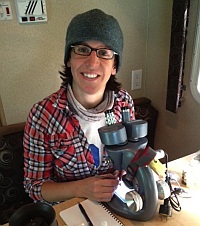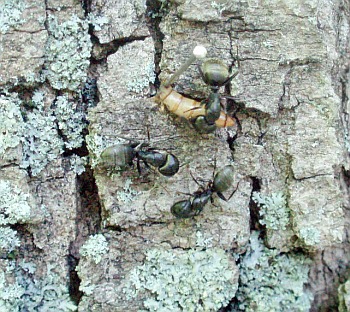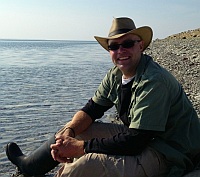Today’s ‘Interview with an Author’ is a Two for One! We spoke with Drs Christopher Buddle and Laura Timms, respectively senior and corresponding author on the recent PeerJ article “Vertical heterogeneity in predation pressure in a temperate forest canopy”. We were very interested in hearing about their experience with us.
Dr. Buddle is a Professor of Arthropod Ecology at McGill University. Be sure to follow him on Twitter and check out his Arthropod Ecology blog.
Dr. Timms is a Postodoctoral Research Fellow at McGill University. She describes herself as an insect ecologist, parasitoid enthusiast, and lover of trees. You can follow her on Twitter and visit her website.
PJ: Can you both tell us about you and your background?

CB: I grew up in Ontario, canoeing, fishing and hiking. I developed a healthy love for nature and the study of nature, and this led me to completing an undergraduate degree in ecology from the University of Guelph. I completed my PhD at the University of Alberta in 2001, working on spider diversity in the boreal forest. After a stint as a post-doc at Miami University in Ohio, I began my job as a Professor at McGill. Since arriving at McGill, I have worked in the area of arthropod ecology, with a common research theme about biodiversity patterns and the processes underlying these patterns. I study in cornfields, forests, the Arctic tundra, and my own backyard. About seven or eight years ago, I realized that we know remarkably little about the arthropods in the tree canopies in north-temperate deciduous forests. That led to some research grants on the topic, and in turn, graduate students begin working in tree canopies. The current paper is the result of a former MSc student’s project (the lead author, Kathleen Aikens).

LT: When I was a kid I wanted to be an author/naturalist/vet like James Herriot or Gerald Durrell, and I went to the University of Guelph for my undergraduate degree with that ambition in mind. My plans went off track in first year when I discovered that I really liked fieldwork in zoology, and I was attracted to entomology in particular because of it seemed full of unanswered questions. I did my MSc and PhD at the University of Toronto, studying invasive forest insects, and this is when I became very interested in community ecology. I love collecting and exploring large ecological data sets, asking questions about what happens to a community of insects as a whole when some variable is changed. The best part is that my job does involve writing and natural history, so I’m really living up to and beyond my childhood dreams.
PJ: Can you tell us about the research you published with us, and why it is interesting?
Here’s a plain language summary of the work: Tree canopies, including those in deciduous forests in southern Quebec, are important for many different animals, including insects and spiders. These small, marvelous creatures crawl up and down trees with regularity, feed upon the leaves of trees, feed upon each other, and are food for animals such as birds and bats. Past research has shown that many species of insects and spiders live in tree canopies, and in general, more insects and spiders are found closer to the ground compared to the very tops of the trees. This makes sense, since deciduous tree canopies often need to be recolonized each spring, and tree canopies are relatively harsh environments – they are windy, hot, and often-dry places as compared to the forest floor. What we don’t know, however, is whether the insects and spiders avoid the tree canopies because they may be eaten more frequently in the canopy as compared to the understory. The objective of this research was to test this question directly, and find out whether insects and spiders are arranging themselves, vertically, because predators may be preferentially feeding on them along this vertical gradient. This is a very important area of study since biodiversity is highly valued and important in forests, but we cannot fully appreciate the status of this diversity without discovering what controls it.

We did this work by using two experiments that involved manipulating different factors so we could get at our question in the most direct way possible. In the first experiment, we made ‘cages’ out of chicken wire and enclosed branches of sugar maple trees in the cages. We did this at the ground level all the way to the tops of trees, using a ‘mobile aerial lift platform’. These cages acted to keep out large predators, such as birds, but allowed insects and spiders to live normally on the vegetation. We counted, identified, and tracked the insects and spiders both within these cages, and in adjacent branches that did not have cages (the ‘control’). By comparing the control to the cage, we could find out whether feeding activity by larger vertebrate predators affected insects and spiders, and whether this differed when comparing the ground to the top of the trees. In the second experiment, we used small pins and attached live mealy worms (larvae of beetles) to the trunks of trees, and we did this in the understory all the way up to the canopy. We watched what happened to these mealy worms, and compared what happened during the day and overnight. This is called a ‘bait trial’, and let us figure out what sort of predators are out there in the environment, and in our case, whether they fed more often in the canopy compared to the ground-level. This second experiment was designed for seeing the effects of insect and spider predators along a vertical gradient whereas the first experiment was focused more on vertebrate predators (e.g., birds).

Our results from the first experiment showed that the cages had an effect: more insects and spiders were found when they were protected from predation by birds. Birds are playing a big role in forest canopies: they are feeding on insects and spiders, and in the absence of vertebrate predators, you might speculate more insects and spiders would occupy trees. Our second experiment showed that ants were important predators along the tree trunks, and overall, the most invertebrate predators were found in the lower canopy. Both experiments, together, confirmed that the understory contained the most insects and spiders, and was also the place with the highest amount of predation pressure. The take-home message is that there is an effect of predation on insects and spiders in deciduous forests, and this effect changes if you are in the understory as compared to the top of the canopy. We also learned and confirmed that insects and spiders remain a key element of a ‘whole tree’ food web that includes vertebrates such as birds, and that predators in trees tend to feed on insects and spiders along a gradient. Where there is more food, there is more predation pressure! Our work was unique and novel because this is the first time a study of predation pressure was done along a vertical gradient in deciduous forests. It will help better guide our understanding of forest biodiversity, and the processes that govern this diversity.
PJ: With this research, why did you choose to publish in PeerJ rather than some other venue?
CB: I like the idea of Open Access journals, but many of them are too costly. PeerJ is an interesting model, and I like the entire philosophy behind the journal.
LT: I was very interested in the idea of PeerJ, and the best way to learn about something is to experience it.
PJ: How did you first hear about PeerJ?
CB: Through Twitter, of course!
PJ: What do you think about our “Pay once, Publish for life” Membership?
CB: It’s a good model, and I hope it is sustainable. The world of academic publishing is changing rapidly, and new ways of doing business are emerging, including PeerJ’s approach. What is key, however, is that the journal is able to adapt and grow into the future, and keep true to its original philosophy.
PJ: What are the advantages for you to publish with us?
CB: Having the review process quite transparent is really interesting, and provides a terrific opportunity to fully capture the history of a research paper. The communication with the Subject Editor and the technical help was also excellent. Based on looking at past PeerJ articles, I could tell that ecological-type papers were welcome in PeerJ, and some top-notch authors in my field were publishing in PeerJ. Knowing that respected peers are publishing somewhere is an important signal! The cost was also a factor – to have a high quality journal that is Open Access and affordable is important.
PJ: What is the audience that you wish to reach publishing with us?
CB: I believe the audience for PeerJ is different than the traditional Academic audience, because of Open Access. I am, therefore, hopeful that more people will be able to read the article, especially colleagues without access to an institution with large subscriptions to pay walled journals. As mentioned above, I know the work of some of the other authors who have published in PeerJ, and their ‘stamp of approval’ was not only an important point in deciding to submit to PeerJ, but also a sign that they read papers appearing with PeerJ.
PJ: What was your experience of the submission process?
LT: The submission process took a bit of adjusting to, but not much more than any time I have submitted to a journal I have never worked with before. For example, having to upload all the components (abstract, text, figures, etc.) as separate files is not something I have encountered at other places, and took a bit more work on my part. I really appreciated the clear instructions on the website, and every time I had a question or technical issue it was dealt very quickly by PeerJ staff. The attention I received as an author at PeerJ was similar to how it feels to work with a small society journal, even though PeerJ is a much larger scale publication.
PJ: Chris, you tweeted “By in large, my experience w/ @thePeerJ was great, thanks in large part to reviewers (e.g., @GrunerDaniel) & Editor (@docdez)”. Glad to hear you had a good experience with us! Can you share more details about the review process and why you chose to reproduce the complete peer-review history of your article?
CB: The reviews were as high quality as any of the other, great journals I have published with. The peer-review process with rigorous, but fair, and the reviewing team was helpful and constructive. This made the decision to reproduce the complete history quite easy. I also think that showing the complete history provides a nice opportunity for people who are learning about the process of publishing – it gives an important glimpse into the process, and we can all learn and improve by seeing ‘behind the scenes’.
PJ: What do you think to the overall speed of the process?
CB: To be honest, the speed was much slower than my expectations. The ‘buzz’ was that PeerJ was incredibly quick in all ways, and we found it to be faster than many other journals, but certainly not a speedy as expected. However, this is somewhat expected since a lot of the work on our paper was over the (slow) summer months!
PJ: What do you think of the HTML view of your published article and the appearance of the PDF?
CB: I like the HTML version, in a large part because the spacing of the text and text size makes it easy to read. The hyperlinks are good, and the overall quality is very good. It’s a professional-looking paper, as both HTML and PDF.
LT: The finished product does like quite nice. In particular I was struck by the formatting of the tables, with alternating lines highlighted in different colors.
PJ: Did you get any comments from your colleagues about your publication with PeerJ?
CB: The only comments I have received to date have been positive, but I do not think many of my colleagues know about PeerJ, and in many fields, I fear that traditional publishing models are the only acceptable form of publication.
PJ: Today, publishing in a “top journal” is still considered a “stamp of approval” for funding agencies. In your opinion, are your funding bodies supportive of Open Access and PeerJ?
CB: This is a very difficult question. In part, the answer is ‘no’ because the metrics associated with judging journal quality do not always apply to journals such as PeerJ. In part, the answer is ‘yes’ because for my granting agencies, it’s possible to make a clear and solid case about the value of Open Access journals. The bottom line is that it’s the responsibility of researchers to educate and change the thinking about Open Access journals. I also think there is room for many publishing models, and as much as I do support Open Access, I also publish in traditional journals. There are different reasons for publishing in different kinds of journals – it’s a big playground, and there is room and flexibility to support multiple models.
PJ: What would you say to a laboratory director concerned about submitting to us?
CB: Stop worrying. Let go. Give it a try. I would also forward them PDF versions of great papers found within PeerJ.
PJ: And of course, would you submit again with us?
CB: Yes, I will submit to you again. PeerJ needs to be supported, and the best way to support is to submit work to the journal, and to agree to review, if so asked.
PJ: In conclusion, how would you describe PeerJ in three words?
CB: Constructive, Open, Professional
LT: Innovative, Responsive, Accessible
PJ: Thank you for your time, and thank you very much for your excellent feedback!
PeerJ is currently getting first decisions back to authors with a median time of 24 days, and we have hundreds of highly satisfied authors. If you would like to experience the PeerJ process for yourself, then submit your next article to us!

